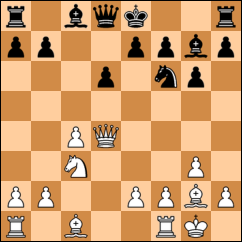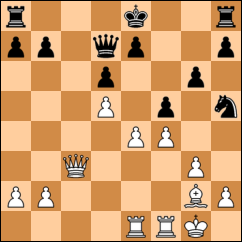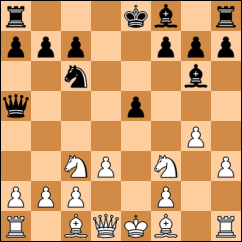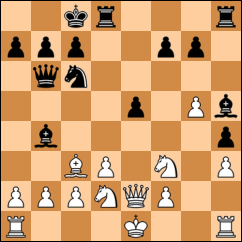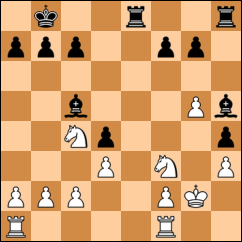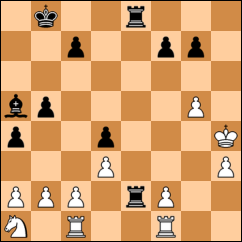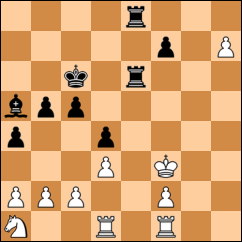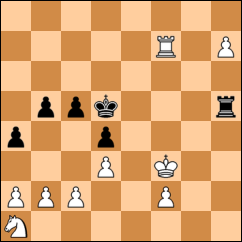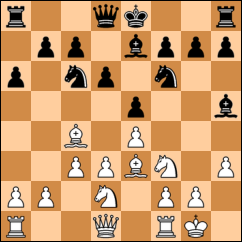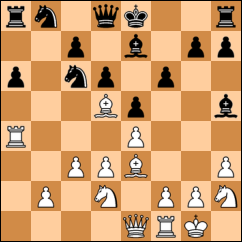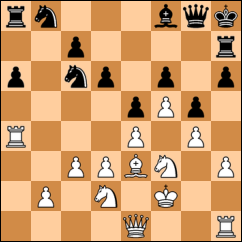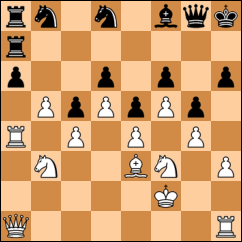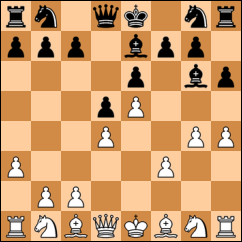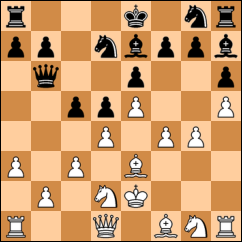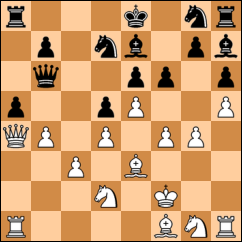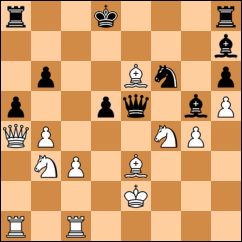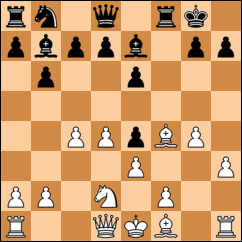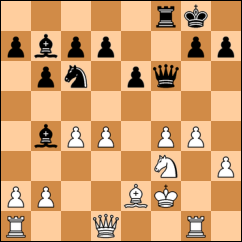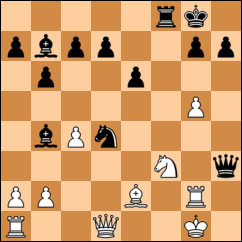Swale Club Championship - Round Three
Thursday 19 November 2015
White: K. French (95) - Black: K. Nevols
For the first time, I approached a game with a sense of confidence. It's funny how a win can do that. But I hoped that I was at last finding my feet as I prepared for my third game in the club championship and using the same motto - simple chess.
1. d4 Nf6
2. Nf3 g6
3. e3 Bg7
4. Be2 d6
5. O-O O-O
6. Nbd2 c6
Both sides quietly develop. I set up the Indian style defence which I am used to with an eye on attacking on the kingside.
7. c3
I had expected 7. c4 which would look very Kings Indian-ish with possible attacking ideas of b4, Ba3, Rc1 and c5.
7. ... Nbd7
7. ... Bf5 or Bg4 is probably more accurate.
8. b3
Planning to directly oppose the Indian bishop. I now considered Qa5 to hit the c-pawn but could not see how to progress after 9. Bb2.
8. . Nb6
But I was a bit unsure about this move, being concerned about an a4-a5 advance. However I had to free my bishop. The e4-e5 move also concerned me but the b3 move indicated the bishop was intending to go the other way. Maybe Nd5 and then N7f6.
9. Bb2 Bf5
That's better. Stops e4 and beginning to roll in the centre.
10. Qc1
I have to confess that I did not understand this move. A rook would be better placed on c1 than the queen.
10. ... Qc7
Planning e5 and to bring the rooks in the centre.
11. Re1
Again I did not understand this. I expected 11. Rd1 as the queen had just got off that square, although Re1 can make some sense if intending Bd1/f1 and e4.
11. ... e5
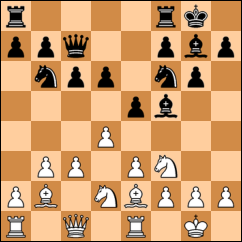
Time to get moving.
12. dxe5 dxe5
13. Nc4 Nxc4
Two advantages here. Firstly I get rid of the knight on b6 which was looking daft and, as I said, vulnerable to an a-pawn push. Secondly, the white bishop now blocks the c-pawn which in turn blocks the other bishop.
14. Bxc4 Bg4
15. Be2 Rad8
16. Rd1 e4!
I had now seen a forced sequence to weaken the white kingside.
17. Nd4 Bxe2
18. Nxe2 Ng4
19. g3
If 19. Nxg3 I had intended h5 20. h3 h4 or 20. h4 Bf6. (After 19. Ng3, the computer prefers 19. ... f5).
19. ... Ne5
This was the position that I had envisaged at move 16. White now has some weak squares around the kingside, I have a strong pawn on e4 with control of d3 and a very active knight. So far so good.
20. Rxd8 Rxd8
Now I was praying for the natural 21. Qc2 (intending Rd1) which falls to the beautiful 21. .. Rd2!! winning a piece.
21. Kg2
Darn it! He saw it. If now 21. .. Nf3 intending Rd2 then White has 22. Nd4.
(I had ruled out placing the knight on d3 as I thought it would be a waste after Nf4. However the computer spots the simple line 21. .. Nd3 22. Qc2 g5! - I did not see this.)
21. ... Qe7
Instead my plan now is to make use of those weak squares and those which I control to infiltrate. Note 22. c4 now walks into Nd3.
22. Qc2 Nd3
Again I see another forced sequence to improve my pieces. However perhaps I should have kept the knights on and played Qf6 with g5.
23. Nf4 Qf6
24. Nxd3 Qf3+
Zwischenzug - or something like that.
25. Kg1 Rxd3
Still in control but running out of pieces. My rook and queen are very well placed so it just remains to activate the bishop and pawns. And I could not see much after 25. ... exd3 26. Qe2.
26. Rf1 h5
27. h4 Be5?
Missing 27. .. g5 28. hxg5 h4. One winning line is 29. gxh4 Qg4+ 30. Kh1 Qxh4+ 31. Kg1 Qxg5+ 32. Kh1 Qh5+ 33. Kg1 Qg4+ 34. Kh1 Rd6 35. f3 Qh3+ 36. Kg1 Rg6+ 37. Kf2 Rg2+.
28. c4 Bc7
I had considered 28. .. Bd6 29. Ba1 Bb4 30. Qb2 Bc3 31. Qb1. This forces the queen off the second rank but taking on e3 seemed to be no more than a draw.
29. Ba1
White now finds a good way to counterattack.
29. .. f6
Forced to break the diagonal.
30. c5!
A very good move which frees up the c4 square for White's queen to become a nuisance.
30 .. Kg7
31. Qc4 Rd5
I could not risk letting the queen into the e6 square and this has the added advantage of bringing the rook over to attack the king if required.
32. Bd4
32. .... Bxg3!?
I should have played Kh7.
At last! I thought this was it. 33. fxg3 Qxg3+ 34. Kh1 Qxh4+ 35. Kg1 Rg5+ and it is soon all over.
I sat back smugly, congratulating myself on a game well played. I went off for a walk, came back, sat down and, with horror, saw his next move a couple of seconds before he played it.
33. Bxf6+
Curses! Blown it again. If I take the bishop, then fxg3 and White has the advantage. I sat and pondered while mentally punching myself. Where did I go wrong? How could I draw, or even lose, a won game?
This is an interesting example of the psychological effect of chess. Bxf6 was a shock and I instantly ruled out Kxf6 - after all, I get my queen pinned. Had I looked at it further, I would have seen 33. .. Kxf6! 34. fxg3 Rd1! We looked at some lines afterwards and, basically, the rooks get swapped off, I pick up the pawn on e3, avoid a perpetual check and push the e-pawn home to win.
I did briefly see Rd1 but decided that there must be something wrong with pinning your own queen and, as my confidence was now shattered, I relied on my instinct - which was wrong in this case.
(And our computer sees something we both overlooked. After 33. Bxf6+ Kxf6 34. fxg3 Rd1! White has 35. Qd4+. But after 35. ... Rxd4 36. Rxf3 gxf3 37. exd4 Kf5 38. Kf2 I think Black has a won king and pawn ending).
33. ... Kh7?
So I decide to pick up some pawns and see where we go.
34. fxg3 Qxg3+
35. Kh1 Qh3+
36. Kg1 Qxe3+
37. Kh1 Qh3+
38. Kg1 Qg3+
39. Kh1 e3
40. Bg5
White could play for a win with 40. Qe4 Qh3+ 41. Kg1 Qg3+ 42. Qg2 Qxg2+ 43. Kxg2 but after 43. Rxc5 44. Kf2 e2 45. Kxe2 Rc2+ 46. Ke3 Rxa2 Black has three pawns for a bishop and might hold.
40. ... Qh3+
Forcing a draw as Rf7 is coming.
A game of two halves. I was happy with how I played at first. White defended and came back well. And I failed to see the correct continuation.
